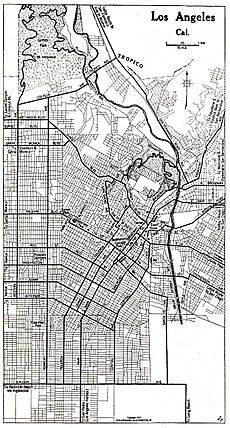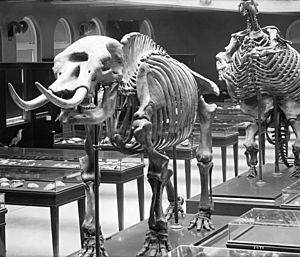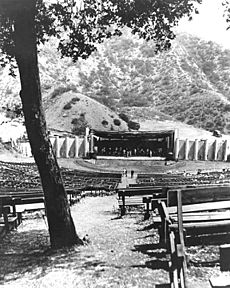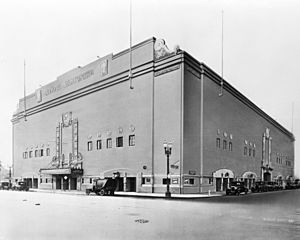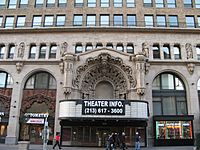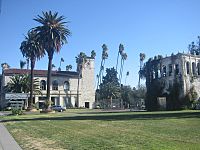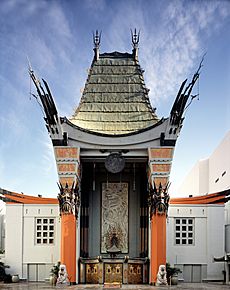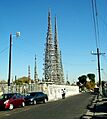Los Angeles in the 1920s facts for kids
The 1920s was a very successful time for Los Angeles, California, United States. During this decade, the name "Hollywood" became famous worldwide for the U.S. film industry. The look of Los Angeles also became well-known everywhere.
Many jobs were available, which brought lots of new people to the city. People came especially from the rural Midwest and Mexico. The city's population more than doubled, growing from 577,000 to over 1.2 million between 1920 and 1929. Many families from Mexico moved to Los Angeles, tripling the Mexican population to 97,000 by 1930. Because of this, Los Angeles became known as the "Mexican capital of the United States."
The 1920s also saw a lot of modern changes. More people started using cars, and the city spread out into huge suburban areas. New business and financial centers also grew in the western parts of the city.
Contents
Los Angeles in the Roaring Twenties
In 1919, about half of Los Angeles's population lived downtown. Most of these people were Anglo-Saxon Protestants. Not many people lived in the hills, and the suburbs were quite empty. At that time, Los Angeles was the 17th largest city in the U.S. It had very little industry, and the oil business was just starting. However, the Hollywood film industry was already a big deal, making silent movies that were popular all over the world.
Things changed a lot during the 1920s. By 1929, as the Great Depression began, Los Angeles had become a major center for Mexican immigrants and Black people. The city grew by about 85 square miles, spreading into the San Fernando Valley to the north and the San Pedro Harbor in the south.
The population became a mix of many different groups. These included Caucasians, Protestants, Blacks (who were the second largest Black community in the U.S. after Baltimore), Jews, Armenians, Italians, and Russians. There were also smaller numbers of Chinese and Japanese people. Many Americans also moved within the country, with 2 million moving to California. About 1.2 million of them settled in Los Angeles. Even with so many new people, the city did not have slums. The population grew incredibly fast, from 102,000 in 1900, to 577,000 in 1920, and over 1.2 million by 1929.
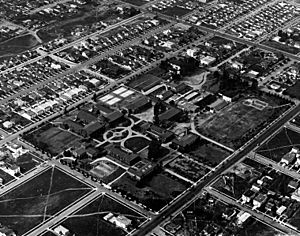
Thanks to this growth, Los Angeles became the fifth largest city in the U.S. by the 1920s. Oil became a huge industry, with plans to get oil from large reserves in Huntington Beach, Long Beach, and Santa Fe Springs. Manufacturing also grew, and Los Angeles became the aviation capital of the U.S. It ranked ninth among the country's industrial cities. Eight major Hollywood studios made 90% of all big movies. They also controlled movie theaters and how films were distributed. The city even got the nickname "Emerald City of Los Angeles." The Port of Los Angeles became the second busiest deep-water port, and the banking industry grew very large.
The economy was booming, fueled by oil and Hollywood real estate. Even with a small slowdown in 1924–25, one-third of the homes in Los Angeles were owned by the people living in them. This was different from other big U.S. cities where most housing was rented.
During the city's growth in the 1920s, the largest fossil area in North America was discovered. This area, called the Rancho La Brea, had prehistoric animal skeletons buried in tar pits. Tar pits are places where tar and methane leak from the ground. This area was being developed, but it was quickly protected. Twelve city blocks were turned into the La Brea Tar Pits and made a county animal fossil area. Over the years, the Natural History Museum of Los Angeles County found more amazing things. These discoveries are now important exhibits at the museum. The displays include skeletons of mammals like saber-toothed cats, giant ground sloths, California lions (weighing over 1,000 pounds), ground storks, and 800 golden eagles, all from the Pleistocene age. Only one human skeleton, that of a woman, was found. It is on display at the museum as the La Brea Woman.
Jewish people also did very well in Los Angeles. Many people from the New York theater world moved to Los Angeles and became leaders in the film industry.
The population of Chinatown went down, but it remained a place for gambling and entertainment. On the other hand, the Japanese population grew. By 1930, about 35,000 Japanese people lived in Los Angeles County. The American-Mexican population also tripled between 1920 and 1930, from 33,644 to 97,116. The number of Black residents grew steadily, from 15,579 to 38,894 during this time.
The famous Hollywood Boulevard was the main street of the Hollywood area. Sunset Boulevard also added to the glamorous feel of Hollywood starting in the 1920s (and still does today). The Hollywood Hills in the background became the home for the rich and famous people from the film industry.
Early 1920s Developments (1920–1923)
In 1920, the Architectural Digest magazine started publishing. It showed pictures of the beautiful gardens created by wealthy residents. This was also a time when women in Los Angeles began to study and work in landscape architecture.
The famous outdoor theater, the Hollywood Bowl, officially opened in 1921. It was built near where the Hollywood Freeway would later be. The Bowl became a place for music concerts, university graduations, and other community events. It got its formal name after March 27, 1921, when its first official event was a Los Angeles Philharmonic performance, an Easter sunrise service attended by about 800 people. The Philharmonic's first official summer concert season was held there in 1922.
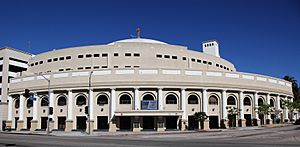
In 1922, people voted to choose a location for the Civic Center. The chosen area was in Downtown Los Angeles, surrounded by Main, Broadway, First, and Temple streets. Voters also approved $7.5 million to build the Civic Hall.
In the 1920s, the famous "Hollywood" sign was created for a residential area in Hollywood. Harry Chandler, who owned the Los Angeles Times newspaper, was behind it. The sign was put up in 1923 and originally said "Hollywood Land Development" as an advertisement. In a storm in 1943, most of the sign was damaged. Later, only the word "Hollywood" was fixed and restored.
On January 1, 1923, a very popular preacher named Aimee Semple McPherson opened Angelus Temple. She was the founder of the International Church of the Foursquare Gospel. The temple is in the Echo Park neighborhood of Los Angeles and is still used today. Seventy years later, it was named a National Historic Landmark.
Mid-1920s Growth (1924–1927)
From 1924 to 1925, Los Angeles worked on making its street lights more beautiful with fancy designs. Funds for this were approved by the city's Art Commission and again in 1927–1928. Torrance, a planned "industrial suburb," became part of Los Angeles.
In 1925, professional boxing was very popular. New rules for 10-round boxing matches meant events were held every weekday except Sunday. In 1924, Jack Doyle helped build the Olympic Auditorium. He had the full support of the Olympic committee because Los Angeles was hosting the 1932 Summer Olympic Games. The auditorium opened on January 13, 1925. Famous people like Jack Dempsey, the World Heavyweight Champion, and film actress Estelle Taylor were there. The stadium could hold 10,400 people and was very well-equipped. Starting in 1925, boxing events were held there every other week. The first heavyweight match on January 13, 1925, was a 10-round fight between Jimmy McLarnin and Fidel LaBarba.
The Hollywood film Ben Hur had its first showing in December 1925 at the Million Dollar Theater. It played for six months! Actors like Ramon Navarro, Francis X Bushman, Douglas Fairbanks, Mary Pickford, and the film's director, Fred Niblo, attended the premiere. It was a grand event with a large orchestra and a stage show.
In 1926, the famous silent film star Rudolph Valentino, known for playing exotic lovers, died at age 31. He is buried in the Hollywood Forever Cemetery, which was previously called Hollywood Memorial Park. Since his death, a mysterious "Lady in Black" has come to mourn at his grave every year on the anniversary of his passing.
Grauman's Chinese Theatre opened in 1927 and quickly became a famous place for movie premieres. It is best known for the many hand and footprint impressions left by celebrities in the cement walkway outside the theater. This tradition started by accident when actress Norma Talmadge stepped into the wet cement. However, the first official handprints were made by silent movie stars Douglas Fairbanks Sr. and Mary Pickford.
Besides the cement prints, the theater building has a red pagoda that is 30 feet tall. It was built with money from Sid Grauman and his partners, as well as Mary Pickford and Douglas Fairbanks. The bells and other Chinese decorations were imported. Chinese artisans built the theater at a cost of $2 million, guided by Moon Quon, a Chinese poet and filmmaker. In 1968, the theater was listed as a historic and cultural landmark. Cecil B. DeMille's film The King of Kings had its premiere here. Fittingly, 85 years later, a Chinese TV maker named TCL bought the theater for $5 million in 2012.
Late 1920s Milestones (1928–1929)
In 1928, the construction of City Hall was finished. This building had been approved in 1922 to replace the older 1888 Romanesque City Hall. The new City Hall is a tall skyscraper built on a base with columns, designed to show power and importance.
Also in 1928, the Los Angeles City Council chose 640 acres in the southern part of Westchester for the city's new airport. Fields of wheat, barley, and lima beans were turned into dirt landing strips, and there were no terminal buildings yet. It was named Mines Field after William W. Mines, the real estate agent who helped with the land deal. The first building, Hangar One, was built in 1929 and is now listed on the National Register of Historic Places.
Images for kids
-
Rose Bowl stadium (built 1921–1922)
-
Los Angeles Memorial Coliseum (built 1921–1923)
-
Watts Towers (construction started 1921)
-
Automobile Club of Southern California (built 1922)
-
Richfield Tower (built 1928–29, demolished 1969)
-
Bullocks Wilshire (built 1929)
-
Jardinette Apartments, (built 1927–28)
-
Exterior view of the Southern Pacific Depot, ca.1918



